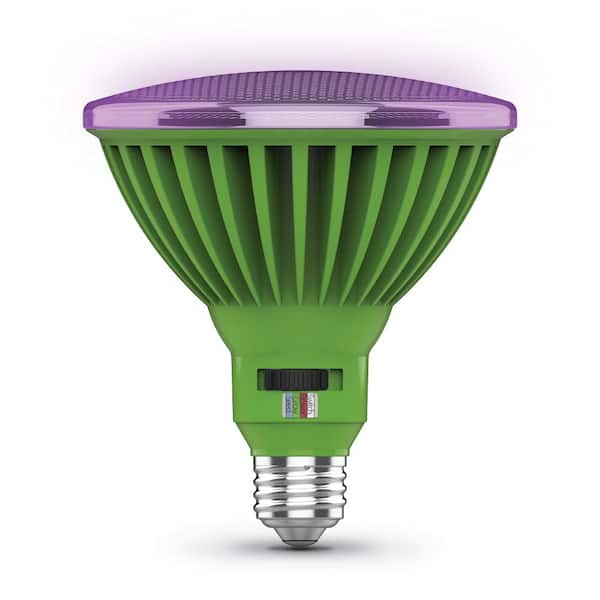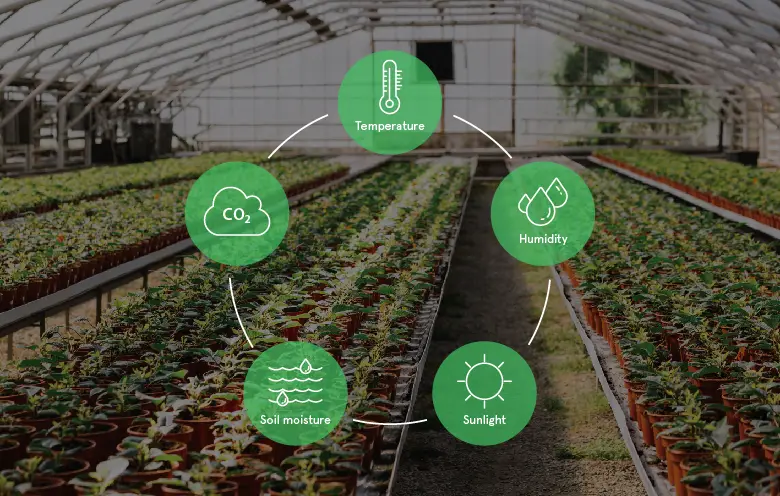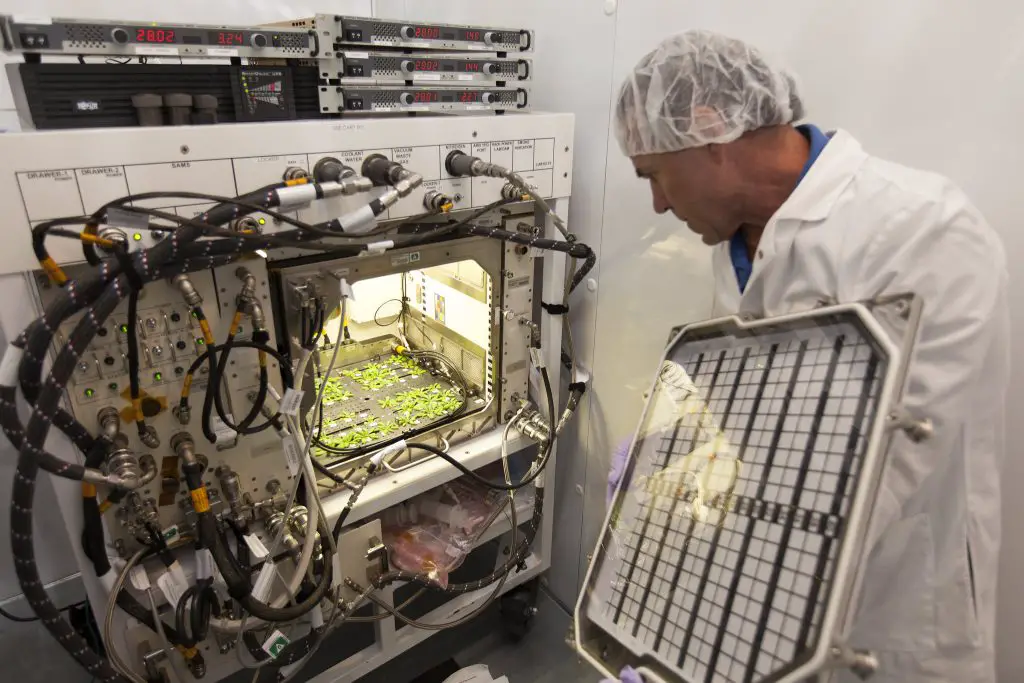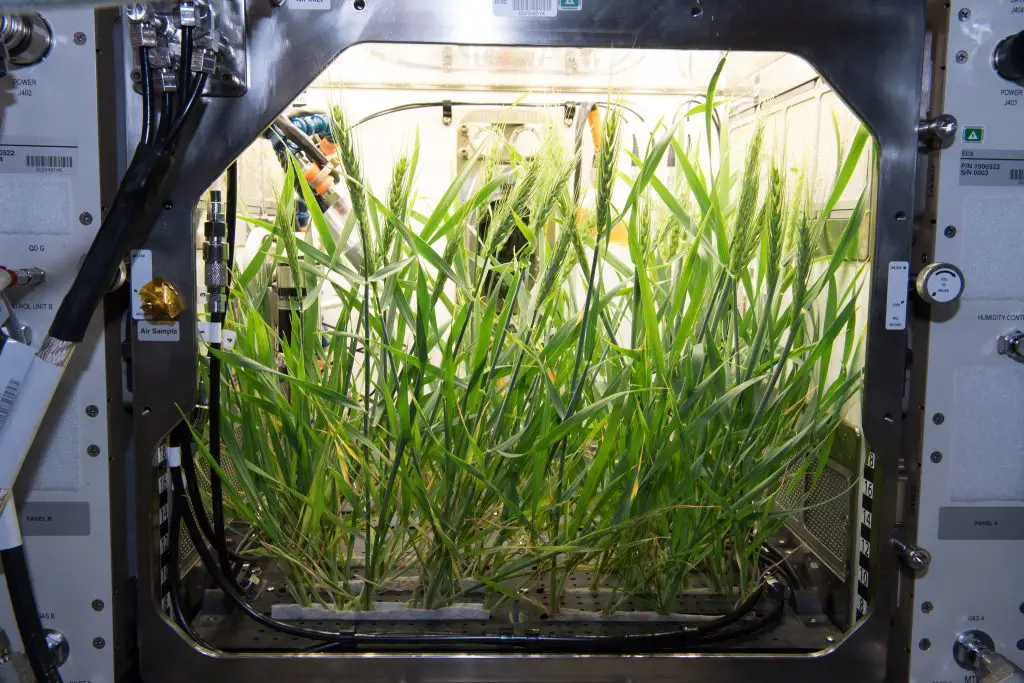A plant grows when exposed to a greenhouse light due to photosynthesis, the process by which plants convert light into energy to fuel their growth. This phenomenon is fundamental for plants because light serves as their primary source of energy.
When plants receive sufficient light, they can produce more chlorophyll, allowing them to absorb more light and maximize photosynthesis. Consequently, this boosts their growth and development. Greenhouse lights provide plants with the necessary light spectrum for photosynthesis, ensuring optimal growth conditions.
As a result, plants can thrive in controlled environments such as greenhouses, enabling gardeners and farmers to cultivate crops year-round regardless of natural light availability.

Credit: www.homedepot.com
The Role Of Light In Photosynthesis
Plants are fascinating organisms that have the incredible ability to harness sunlight and convert it into energy through a process known as photosynthesis. The role of light in photosynthesis is crucial for the growth and development of plants. In this section, we will explore the importance of photosynthesis in plant growth, provide an overview of the process of photosynthesis, and discuss the relationship between light and photosynthesis.
Importance Of Photosynthesis In Plant Growth
- Photosynthesis is essential for the survival of plants as it is the process through which they produce food for themselves. This food, in the form of glucose, provides plants with the energy they need for various metabolic activities.
- The energy produced through photosynthesis is also used to synthesize other important compounds such as proteins, lipids, and nucleic acids, which are vital for the growth and development of plants.
- Photosynthesis is responsible for oxygen production, which is not only necessary for the survival of plants but also for all other organisms on earth.
Overview Of The Process Of Photosynthesis
- Photosynthesis occurs in the chloroplasts, which are specialized structures found in plant cells. These chloroplasts contain a pigment called chlorophyll, which plays a critical role in capturing light energy.
- The process of photosynthesis can be divided into two main stages: The light-dependent reactions and the light-independent reactions (also known as the calvin cycle).
- During the light-dependent reactions, light energy is absorbed by chlorophyll and converted into chemical energy in the form of atp (adenosine triphosphate) and nadph (nicotinamide adenine dinucleotide phosphate).
- In the light-independent reactions, atp and nadph are used to convert carbon dioxide into glucose through a series of complex biochemical reactions.
Relationship Between Light And Photosynthesis
- Light is a primary requirement for photosynthesis to occur. It serves as the energy source that drives the entire process and is absorbed by the chlorophyll molecules in the chloroplasts.
- Different wavelengths of light, particularly red and blue light, are most effective in stimulating photosynthesis. This is why plants often appear green, as they reflect green light and do not absorb it as efficiently as other wavelengths.
- Light intensity also plays a crucial role in photosynthesis. Higher light intensity generally leads to increased photosynthetic activity and consequently, greater plant growth.
- Plants adapt to different light conditions through mechanisms such as adjusting the chlorophyll content, leaf orientation, and stomatal opening and closing.
Photosynthesis is an essential process for plant growth, fueling the production of energy-rich molecules necessary for their development. Light is the driving force behind photosynthesis, and the relationship between light and photosynthesis is a complex and dynamic one. Understanding this intricate interaction is key to optimizing plant growth in various environmental conditions.
Greenhouse Lighting: An Overview
Greenhouse lighting plays a vital role in the growth and development of plants in controlled environments. When it comes to cultivating plants indoors, replicating natural light is not always possible. This is where greenhouse lighting comes into play. In this section, we will explore how greenhouse lighting differs from natural light, the advantages of using greenhouse lighting, and the different types of greenhouse lighting systems available.
How Greenhouse Lighting Differs From Natural Light
- Greenhouse lighting provides a controlled and consistent light source, allowing growers to optimize plant growth in various stages.
- Unlike natural light, greenhouse lighting can be adjusted to meet specific plant requirements, such as providing light in specific spectrums or durations.
- Natural light intensity and duration can vary throughout the day and year, making it less reliable for maintaining consistent plant growth.
Advantages Of Using Greenhouse Lighting
- Enhanced control: With greenhouse lighting, growers have the ability to manipulate light conditions, ensuring optimal growth throughout the year.
- Extended growing seasons: Greenhouse lighting enables plants to grow during periods of reduced natural light, extending their growing seasons.
- Increased yields: By providing plants with supplemental light, growers can boost growth rates and achieve higher crop yields.
- Flexibility: With greenhouse lighting, growers can grow a wide range of plant species, regardless of the availability of natural light.
Different Types Of Greenhouse Lighting Systems
- High-intensity discharge (hid) lighting: Hid lights, such as high-pressure sodium (hps) and metal halide (mh), are commonly used in greenhouse lighting systems. They provide high-intensity light and are suitable for various growth stages of plants.
- Light-emitting diode (led) lighting: Led lights are energy-efficient and can produce specific light wavelengths that suit the needs of different plants. They are known for their long lifespan and low heat generation.
- Fluorescent lighting: Fluorescent lights emit a wide range of light wavelengths, making them suitable for general plant growth. They are energy-efficient and have a relatively lower upfront cost compared to hid and led lighting systems.
Greenhouse lighting offers growers the ability to create optimal growing conditions for plants, irrespective of natural light limitations. The ability to control and adjust light conditions, along with the advantages it brings in terms of increased yields and extended growing seasons, makes greenhouse lighting an invaluable tool for indoor cultivation.
By understanding the different types of greenhouse lighting systems available, growers can select the most suitable option for their specific plant needs.
The Effect Of Greenhouse Lighting On Plant Growth
Growing plants in a greenhouse is a popular practice among gardeners and farmers alike. The controlled environment allows for optimal conditions, including lighting, to promote plant growth. When it comes to the effect of greenhouse lighting on plant growth, several factors come into play.
By understanding the impact of light intensity, the optimal light spectrum for different plant species, and the duration of light exposure, we can maximize the growth and productivity of our plants. Let’s dive deeper into each of these factors.
Impact Of Light Intensity On Plant Growth
- Light intensity plays a crucial role in plant growth as it directly affects the process of photosynthesis.
- Higher light intensities generally result in increased photosynthetic activity, leading to faster and healthier plant growth.
- However, it is important to note that different plant species have varying light intensity requirements, so finding the right balance is key.
- Insufficient light intensity can lead to stunted growth and weak, leggy plants, while excessive light intensity can cause heat stress and damage to the plant tissues.
Optimal Light Spectrum For Different Plant Species
- Plants have specific light spectrum requirements for different stages of growth, including germination, vegetative growth, and flowering or fruiting.
- Blue light promotes vegetative growth, while red light is essential for flowering and fruiting.
- Some plants may also require ultraviolet (uv) or infrared (ir) light for specific physiological processes.
- By providing the correct light spectrum, we can ensure that our plants receive the necessary wavelengths for optimal growth and development.
Duration Of Light Exposure And Its Influence On Plant Growth
- The duration of light exposure, also known as photoperiod, plays a significant role in regulating various plant processes such as flowering, tuber formation, and seed germination.
- Some plants require specific day lengths to initiate flowering, while others may require extended periods of darkness.
- Controlling the duration of light exposure in a greenhouse allows us to manipulate the growth and flowering patterns of our plants.
- It is important to understand the natural photoperiod requirements of each plant species to provide the ideal light exposure for their growth and development.
The effect of greenhouse lighting on plant growth is multifaceted. Light intensity, the light spectrum, and the duration of light exposure all play crucial roles in shaping the growth and productivity of plants. By understanding and optimizing these factors, we can create the ideal conditions for our plants to thrive in a greenhouse setting.
So, whether you are a hobby gardener or a commercial farmer, paying attention to the lighting requirements of your plants will undoubtedly yield impressive results.
Understanding The Response Mechanisms
A Plant Growing In Response To A Greenhouse Light
Have you ever wondered how plants respond to different colors of greenhouse lighting? Understanding the mechanisms behind this fascinating process can provide valuable insights into optimizing plant growth. In this section, we will explore the response of plants to different colors of greenhouse lighting, the role of photoreceptors in light perception, and the signal transduction pathways involved in plant growth response.
Response Of Plants To Different Colors Of Greenhouse Lighting:
- Plants have the ability to perceive and respond to specific colors of light emitted by greenhouse lighting.
- Red and blue lights are particularly important for plant growth, as they are the most effective in driving photosynthesis.
- Red light promotes stem elongation, flower bud formation, and overall plant growth.
- Blue light, on the other hand, influences leaf development, chlorophyll synthesis, and phototropism.
- Green light is less effective in promoting plant growth, as plants predominantly reflect rather than absorb this color of light.
Role Of Photoreceptors In Light Perception:
- Photoreceptors are specialized proteins found in plants that enable them to sense and perceive light.
- The two main classes of photoreceptors involved in plant light perception are phytochromes and cryptochromes.
- Phytochromes primarily respond to red and far-red light, playing a significant role in regulating plant growth and development.
- Cryptochromes, on the other hand, are responsible for perceiving blue and uv-a light, affecting various physiological processes in plants.
Signal Transduction Pathways Involved In Plant Growth Response:
- When plants perceive light through photoreceptors, a series of biochemical reactions is triggered, leading to changes in gene expression and ultimately influencing plant growth.
- The signaling pathways involved in plant response to light include the phytochrome-dependent pathway and the cryptochrome-dependent pathway.
- In the phytochrome-dependent pathway, the activation of phytochromes leads to the activation of various downstream signaling components, resulting in changes in gene expression and physiological responses.
- The cryptochrome-dependent pathway, on the other hand, involves signaling through cryptochromes and the subsequent regulation of gene expression.
The response of plants to different colors of greenhouse lighting is a complex process that involves the perception of light through photoreceptors and the activation of signal transduction pathways. By understanding these mechanisms, we can manipulate greenhouse lighting to optimize plant growth and enhance crop productivity.
Tips For Efficient Greenhouse Lighting
Creating A Light Schedule For Different Growth Stages
A well-planned light schedule is essential for promoting healthy growth in plants within a greenhouse. To optimize growth at different stages, consider the following tips:
- Seed germination stage: During this stage, provide 14-16 hours of light per day to encourage strong root development and seedling growth.
- Vegetative growth stage: Increase the light exposure to 16-18 hours per day to support leaf and stem development.
- Pre-flowering stage: Reduce the light exposure to 10-12 hours per day to initiate the flowering process.
- Flowering and fruiting stage: Increase the light exposure to 12-14 hours per day to enhance flower and fruit production.
Regularly monitor and adjust the light schedule as necessary, considering the specific needs of the plants in each growth stage. Remember to provide a period of darkness for the plants to rest and undergo essential metabolic processes.
Choosing The Right Light Source For Specific Plants
Finding the ideal light source for your greenhouse depends on various factors, including the type of plants, growth stage, and energy efficiency. Consider the following options:
- Led grow lights: These versatile lights provide a tailored spectrum of light, promoting healthy growth and minimizing energy consumption.
- High-intensity discharge (hid) lights: Hid lights include metal halide (mh) and high-pressure sodium (hps) bulbs. Mh lights are ideal for vegetative growth, while hps lights are suitable for flowering and fruiting stages.
- Fluorescent lights: An affordable option, fluorescent lights are excellent for seedlings and young plants. They emit less heat compared to other light sources.
Each plant species has unique light requirements, so research the specific needs of your plants before selecting the appropriate light source.
Importance Of Regular Monitoring And Adjusting Lighting Conditions
Consistently monitoring and adjusting the lighting conditions in your greenhouse is crucial for ensuring optimal plant growth. Consider the following key points:
- Light intensity: Regularly measure the light intensity using a light meter and adjust the distance between the lights and the plants accordingly.
- Light spectrum: Check if the light spectrum provided by your chosen light source matches the specific requirements of your plants.
- Light duration: Monitor the length of light exposure at various growth stages and make necessary adjustments to maintain an optimal light schedule.
- Light positioning: Verify that the lights are positioned appropriately to provide equal coverage to all plants, preventing shading or burning.
By regularly evaluating and adjusting the lighting conditions, you can provide the ideal environment for your plants and maximize their growth potential.
Case Studies: Plants Thriving Under Greenhouse Lighting
It’s fascinating to witness the adaptability of plants when exposed to artificial light environments within greenhouses. Through various case studies, we have seen remarkable transformations and improvements in plant growth and development. Let’s delve into some specific examples of plants that thrive under greenhouse lighting using the three main categories of succulents, leafy greens, and flowering plants.
Succulents: Adapting To Artificial Light Environments
Succulents, known for their ability to store water in their leaves and stems, have been found to adapt well to artificial light environments within greenhouses. Here are some key points:
- Succulents are highly efficient in utilizing artificial light to carry out photosynthesis, making them ideal for greenhouse cultivation.
- These plants have displayed increased growth rates and vibrant colors when exposed to controlled lighting.
- Artificial light allows for the cultivation of succulents throughout the year, providing optimal conditions for their growth and survival.
- Optimal light wavelengths and intensity should be considered to ensure the best results for succulent growth under greenhouse lighting.
Leafy Greens: Achieving Increased Yield With Controlled Lighting
Leafy greens such as lettuce, spinach, and kale have shown significant improvements in terms of yield and quality when grown under controlled lighting conditions in greenhouses. Here are the key points:
- Controlled lighting in greenhouses allows for the manipulation of light duration, intensity, and spectrum, resulting in increased productivity.
- With proper lighting management, leafy greens can be grown year-round, eliminating the dependency on specific growing seasons.
- Greenhouse lighting enables the regulation of temperature, humidity, and other environmental factors, creating an optimized growth environment for leafy greens.
- These plants respond well to different light wavelengths, optimizing photosynthesis and promoting healthy growth.
Flowering Plants: Manipulating Light To Enhance Blooming
Greenhouse lighting has opened new possibilities for flowering plants, enabling growers to manipulate light conditions to enhance blooming and extend flowering periods. Here are the key points:
- By controlling the duration and intensity of light exposure, flowering plants can be induced to bloom earlier or for more extended periods.
- The manipulation of light wavelengths allows for the stimulation of specific flowering responses in plants, resulting in desired floral traits.
- Greenhouse lighting provides the opportunity to grow flowering plants that are not native to the local climate, expanding the range of available species.
- With careful light management, flowering plants can be grown to their full potential, offering an enchanting display of colors and fragrances.
The success stories of plants thriving under greenhouse lighting are truly remarkable. These case studies demonstrate the adaptability and benefits of exposing plants to controlled lighting environments. Whether it’s succulents, leafy greens, or flowering plants, greenhouse lighting offers endless possibilities for cultivating healthy, vibrant, and productive flora.
Potential Limitations Of Greenhouse Lighting
Greenhouse lighting plays a crucial role in promoting plant growth and ensuring optimal conditions for cultivation. However, there are several potential limitations that need to be considered to ensure the effectiveness of the lighting system. Let’s explore some key factors to keep in mind:
Energy Consumption And Sustainability Considerations
- Energy consumption is a critical factor when it comes to greenhouse lighting. It is important to choose energy-efficient lighting systems to minimize electricity usage and reduce costs.
- Implementing sustainable practices in greenhouse operations is becoming increasingly important. Consider using led lights that consume less energy and have a longer lifespan compared to traditional lighting options.
- Timers and sensors can be employed to optimize energy usage by adjusting the lighting levels based on plant requirements and environmental conditions.
Potential Issues With Excessive Or Insufficient Lighting
- Providing plants with excessive light can lead to photoinhibition, causing significant stress and damage to the plants. This can manifest as stunted growth, bleaching of leaves, or even plant death.
- On the other hand, insufficient lighting can hinder plant development and result in tall, leggy growth or reduced yield. It is crucial to strike a balance to provide the right amount of light for optimal photosynthesis and growth.
- Measuring light intensity and duration with light meters or integrating sensors can help maintain an ideal lighting environment for the plants.
Minimizing Potential Plant Stress And Negative Effects
- Beyond light intensity, the quality of light also plays a vital role in plant growth. Different plants have specific light requirements in terms of color spectrum and intensity. Consider using full-spectrum lighting to ensure plants receive the necessary wavelengths for their growth stages.
- Regular monitoring and adjustment of lighting levels can help minimize plant stress. Periodically assessing plant responses and adjusting lighting duration or intensity accordingly can prevent long-term negative effects.
- Experimenting with different lighting techniques, such as using diffusers or reflective surfaces, can help distribute light evenly and mitigate potential hotspots or shadows.
By addressing these potential limitations, greenhouse operators can optimize plant growth while promoting energy efficiency and sustainability. Striking the right balance with lighting conditions ensures healthier plants, higher yields, and ultimately more successful greenhouse cultivation.
Best Practices For Greenhouse Lighting Management
A Plant Growing In Response To A Greenhouse Light
As the demand for year-round produce continues to rise, greenhouse gardening has become an increasingly popular practice. One of the key factors that contribute to the success of greenhouse cultivation is the management of lighting. By providing the right amount and quality of light, plants can thrive and grow efficiently in these controlled environments.
In this blog post, we will explore the best practices for greenhouse lighting management, including the incorporation of smart lighting technologies, the implementation of light diffusers and reflective surfaces, and the use of supplemental lighting techniques.
Incorporating Smart Lighting Technologies For Efficient Use:
- Using light sensors to automatically adjust the intensity and duration of artificial lighting based on natural light levels.
- Implementing timers or smart controls to ensure consistent and optimized lighting cycles.
- Installing motion sensors to activate lighting only when necessary, minimizing energy consumption and reducing costs.
- Utilizing led lights that offer a wide spectrum of light, allowing for tailored lighting conditions for different plant species.
- Integrating wireless connectivity for remote monitoring and control of lighting systems.
Implementing Light Diffusers And Reflective Surfaces:
- Using diffusers to distribute light more evenly across the greenhouse, preventing hotspots and ensuring uniform growth.
- Installing reflective surfaces such as white walls or aluminum foil to bounce light back onto plants, maximizing its effectiveness.
- Optimizing the positioning of reflective surfaces to redirect light towards shadowed areas within the greenhouse.
Considering The Use Of Supplemental Lighting Techniques:
- Using artificial lighting to extend the photoperiod during periods of low natural sunlight, promoting continuous growth.
- Selecting the appropriate light spectrum (such as red or blue) for specific growth stages of plants to enhance photosynthesis and boost yield.
- Employing vertical lighting systems to ensure light reaches plants at all levels, especially in multi-tiered setups.
- Evaluating the cost-effectiveness of different supplemental lighting options, such as high-pressure sodium (hps) lamps or led fixtures.
By implementing these best practices, greenhouse growers can optimize their lighting management, ensuring healthy and productive plant growth throughout the year. Whether it’s incorporating smart lighting technologies, utilizing light diffusers and reflective surfaces, or considering supplemental lighting techniques, finding the right combination for your specific greenhouse setup can lead to impressive results.
So, go ahead and take the next step towards creating the perfect environment for your plants to thrive and flourish!
Frequently Asked Questions Of A Plant Growing In Response To A Greenhouse Light
How Does Light Affect Plant Growth?
Light is essential for plant growth as it plays a crucial role in the process of photosynthesis. Light provides the energy needed for plants to convert carbon dioxide and water into glucose and oxygen. Different wavelengths of light have different effects on plants, triggering specific growth responses.
What Is The Role Of A Greenhouse Light In Plant Growth?
A greenhouse light serves to supplement or replace natural sunlight to provide plants with the necessary light spectrum and intensity for optimal growth. It helps extend the growing season, increase crop yield, and facilitate the cultivation of plants that require specific light conditions.
What Are The Benefits Of Using A Greenhouse Light?
Using a greenhouse light allows for greater control of the growing environment. It enables year-round cultivation, protection against harsh weather conditions, and the ability to grow plants that require specific light cycles. This can result in improved crop quality, increased productivity, and enhanced overall plant health.
Conclusion
To conclude, the fascinating phenomenon of a plant growing in response to a greenhouse light is truly remarkable. The use of led lights in greenhouses, with their specific wavelengths, enables plants to photosynthesize more efficiently, leading to faster and healthier growth.
The controlled environment of a greenhouse offers ideal conditions for plant development, allowing for year-round production and protecting crops from harsh weather conditions. This innovative method not only benefits commercial growers by increasing productivity, but also offers a sustainable solution to feed a growing population.
Additionally, the ability to customize light spectrums can optimize plant growth and even enhance specific characteristics, such as taste, color, and nutritional value. As climate change continues to pose challenges to agricultural practices, the adoption of greenhouse technologies provides hope for a more resilient and productive future.
By harnessing the power of greenhouse lights, we can foster a greener, more sustainable world in which plants thrive and contribute to our overall well-being.




